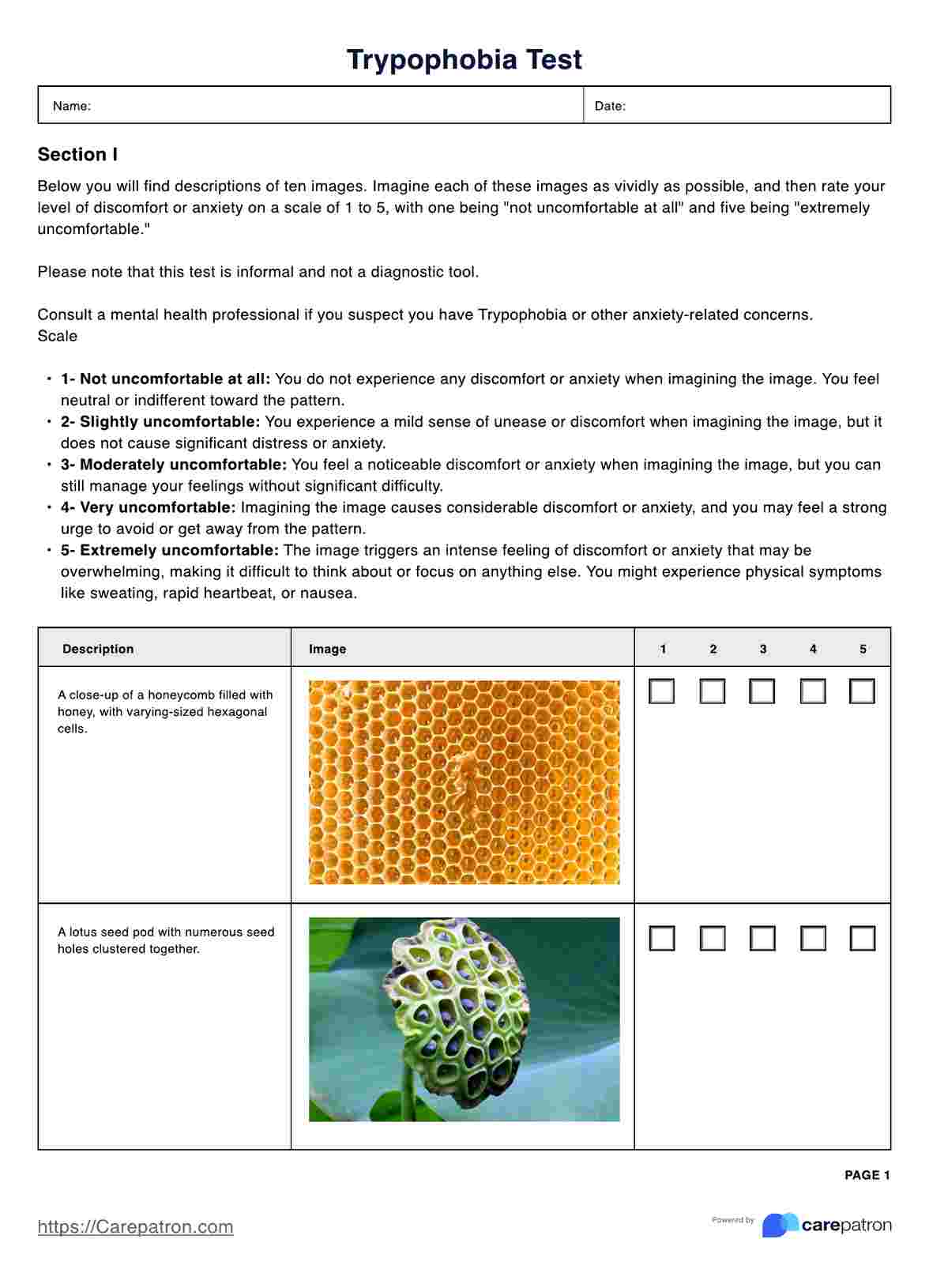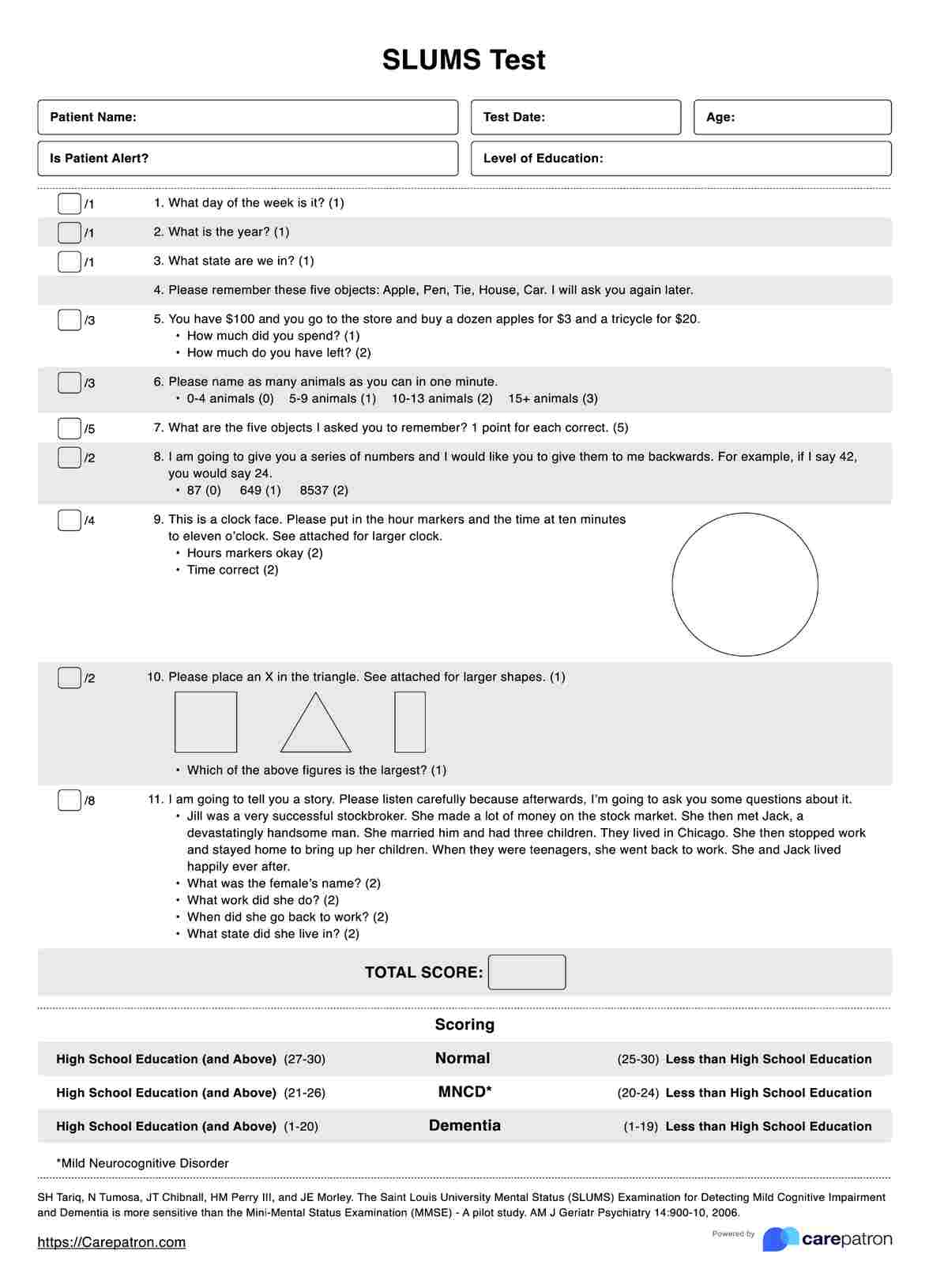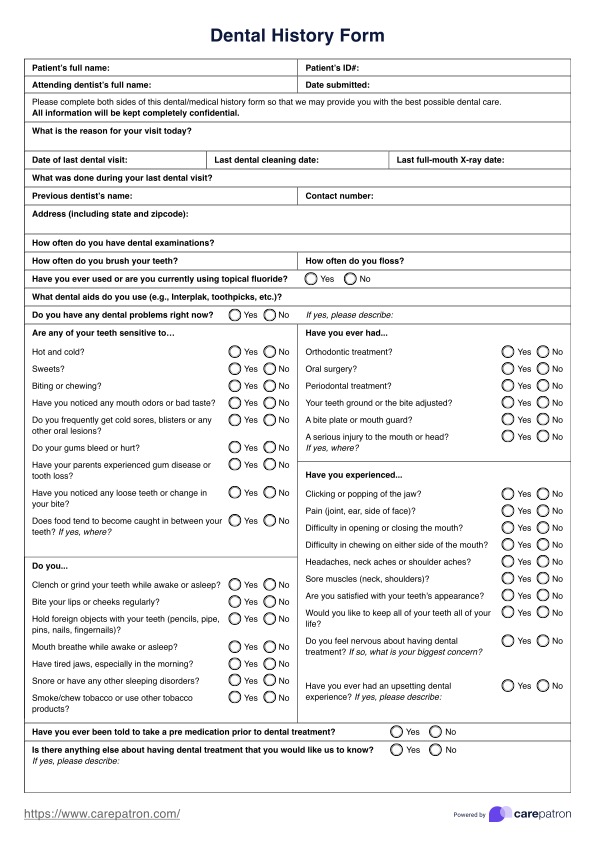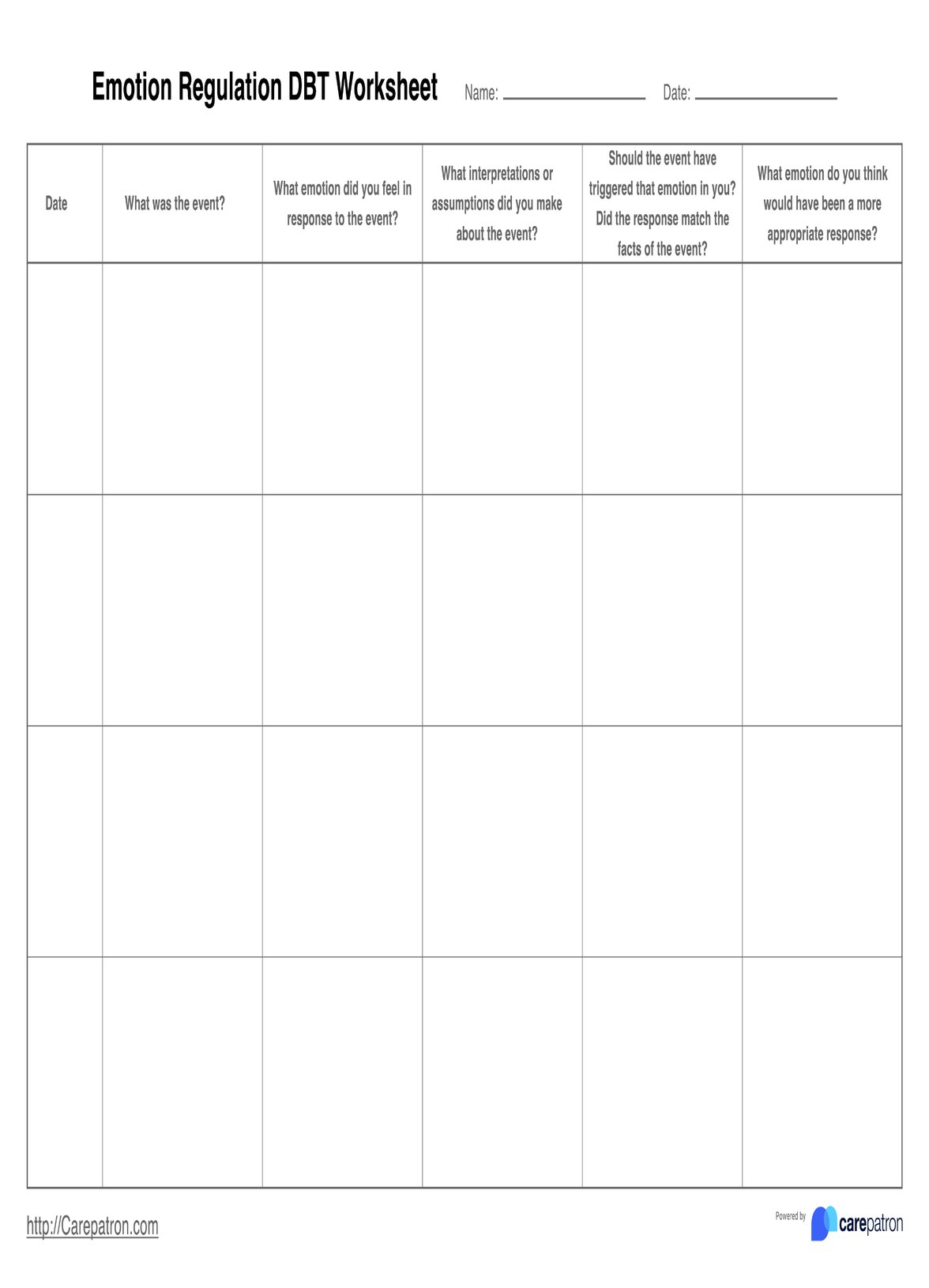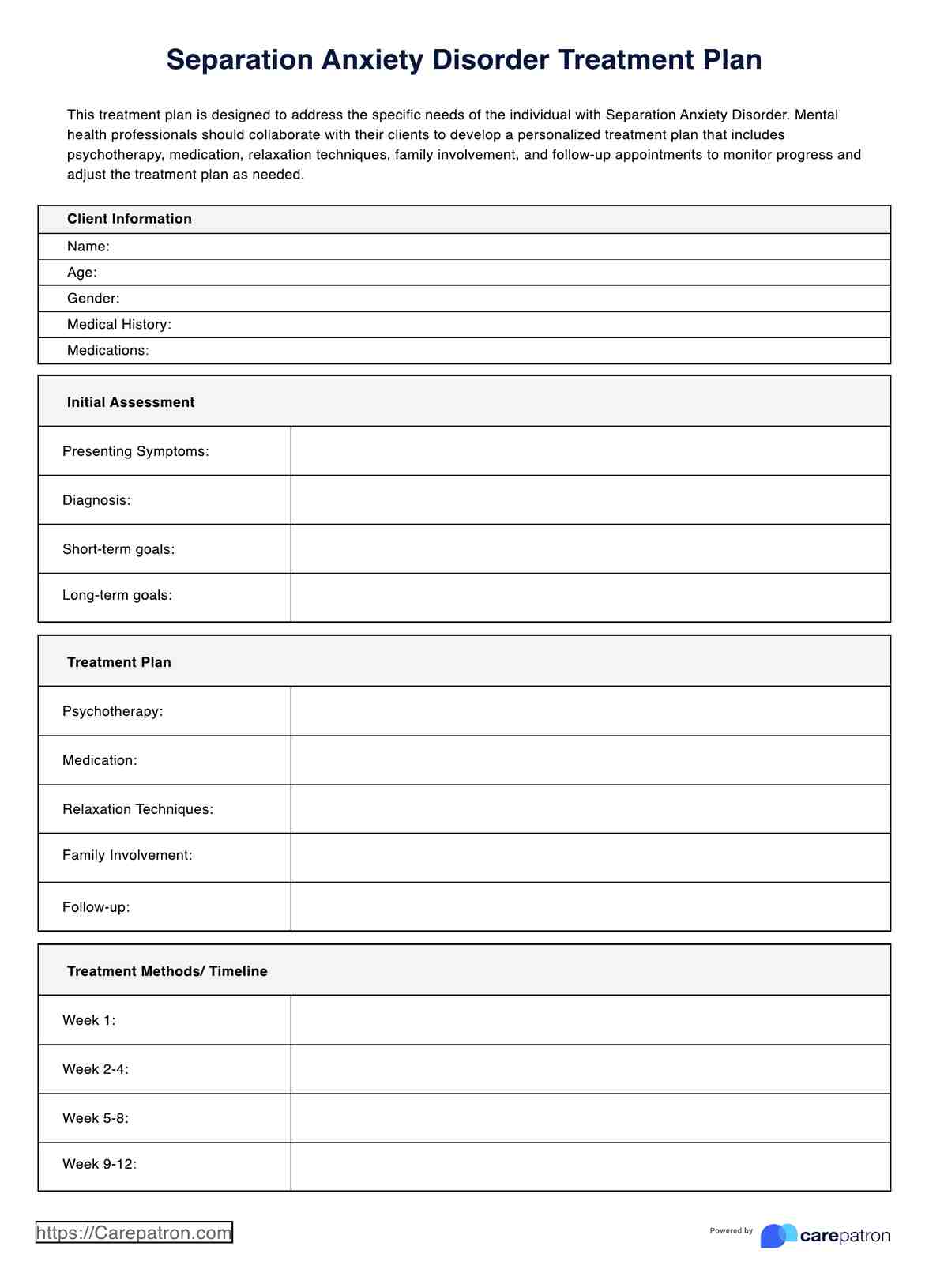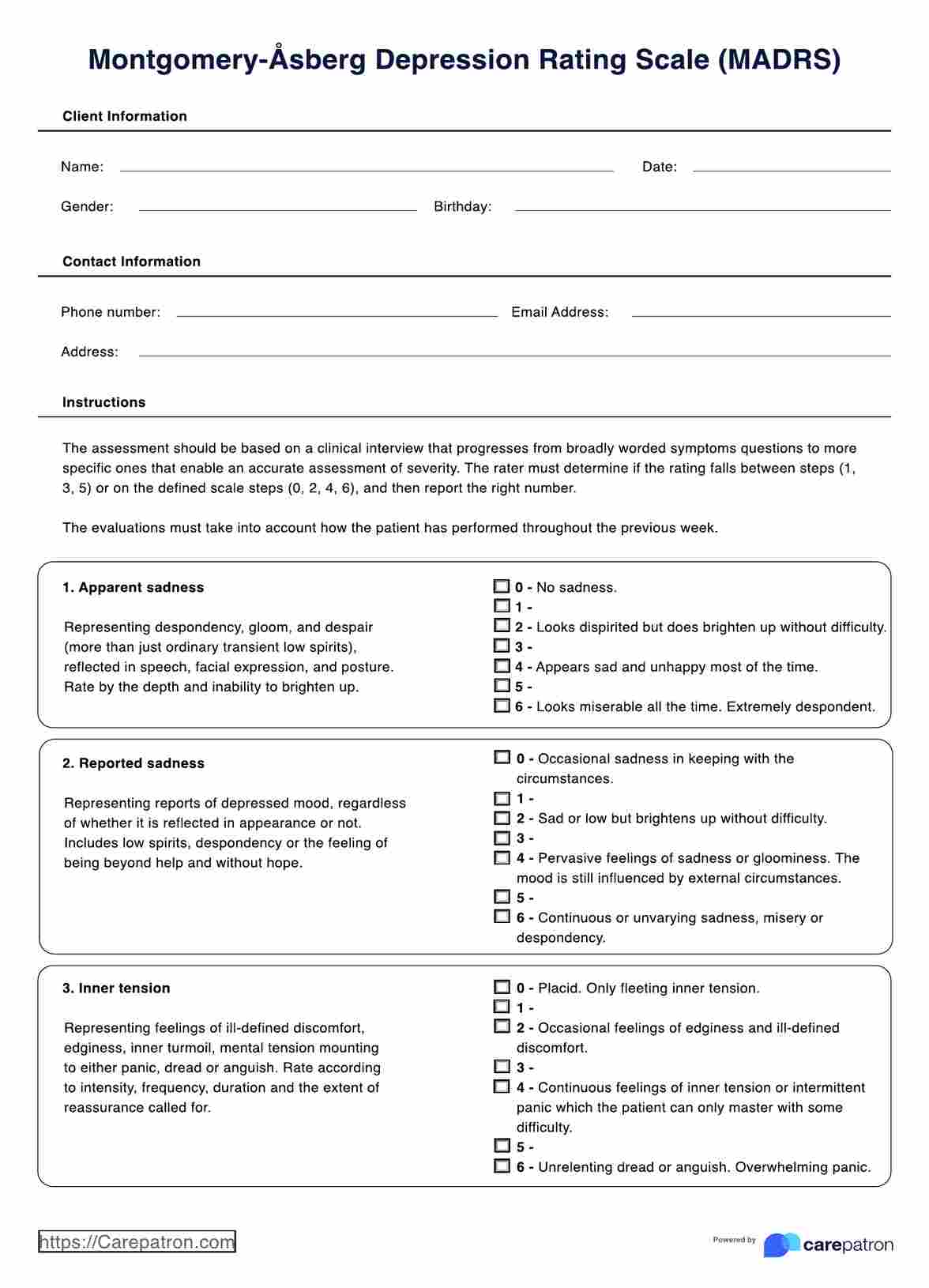Occupational Self Assessment
Explore the comprehensive Occupational Self Assessment (OSA) guide with examples and a free PDF download.


What is an Occupational Self Assessment?
The Occupational Self Assessment (OSA) is a pivotal tool in occupational therapy. It emphasizes a client-centered approach to evaluate an individual's perception of their occupational competence and the significance of various activities in their life. This assessment is integral in capturing clients' views on their abilities and challenges in daily occupations, fostering a collaborative and personalized treatment planning process.
Core components of OSA:
- Client-centered evaluation: The OSA places the client at the center of the assessment process. It respects and prioritizes their perspective, ensuring the therapy aligns with their experiences and perceptions.
- Holistic occupational analysis: The assessment encompasses a broad spectrum of daily activities, including self-care, productivity, and leisure. This comprehensive approach ensures that all facets of the client's life are considered in the therapy planning.
- Dual focus on competence and value: Clients are asked to rate their perceived competence in various activities and their importance to these activities. This dual focus is essential as it provides insights into the client's ability to perform tasks and the personal significance of these tasks. Understanding what clients value helps in tailoring interventions that are effective and meaningful to them.
- Identification of intervention areas: By highlighting areas where clients perceive challenges or lower competence, the OSA helps therapists and clients pinpoint specific intervention needs. This targeted approach ensures that therapy is focused and efficient.
- Establishing therapy priorities: The OSA aids in setting priorities for therapy based on the client's own ratings of importance. This prioritization is crucial for engaging clients in therapy and ensuring that the interventions align with their goals and aspirations.
- Enhancing occupational performance and well-being: The ultimate goal of the OSA is to enhance the client's occupational performance and overall well-being. By providing a clear picture of the client's occupational profile, the OSA guides therapists in developing interventions that improve their ability to engage in meaningful activities, enhancing their quality of life.
The Occupational Self Assessment is more than just a tool for measuring competence; it is a means of understanding the client's world from their perspective. It respects the client's autonomy and choice, making it an invaluable component of occupational therapy.
The OSA's emphasis on client-centeredness, holistic assessment, and collaborative goal-setting makes it a key instrument in facilitating effective and personalized occupational therapy interventions.
Occupational Self Assessment Template
Occupational Self Assessment Example
When should an Occupational Self Assessment be used?
Our printable Occupational Self Assessment (OSA) is an essential tool in occupational therapy, designed to be used in various settings and with a diverse range of clients. Its application is particularly beneficial in several key areas:
Diverse clinical settings
The OSA is highly adaptable and can be effectively utilized in various therapeutic environments, including acute inpatient rehabilitation, outpatient clinics, community health settings, and mental health services. This versatility ensures that the OSA can meet the unique demands of different clinical contexts, providing valuable insights into clients' occupational needs and challenges.
Broad client range
The OSA is suitable for a wide spectrum of clients, encompassing children, adults, and older adults. It particularly benefits individuals experiencing physical, mental, or cognitive impairments. By assessing a client's perceived occupational competence and importance in various activities, the OSA offers a comprehensive understanding of their occupational profile, regardless of age or condition.
Initial and ongoing assessment
Implementing the OSA at the onset of the occupational therapy process is crucial for establishing a baseline understanding of the client's perceived abilities and challenges. Continually using the OSA throughout the therapy process, particularly at its conclusion, allows for monitoring progress and the effectiveness of interventions. This ongoing assessment ensures that treatment plans remain relevant and responsive to the client's evolving needs.
Client-centered goal setting
The concept of client-centered care is central to the ethos of occupational therapy, and the OSA is a vital tool. It empowers clients to actively participate in therapy by reflecting on and articulating their personal goals and priorities.
This process not only fosters a deeper engagement in therapy but also ensures that the goals set are aligned with the client's values and aspirations, thereby enhancing the overall effectiveness and relevance of the therapy.
The Occupational Self Assessment should be used whenever there is a need to understand a client's perspective on their occupational abilities and challenges. Its flexibility across various settings and client groups and its focus on client-centered goal setting make the OSA a valuable asset in the occupational therapy toolkit. The OSA plays a crucial role in developing effective, personalized, and meaningful therapeutic interventions by providing insights into the client's self-perception and priorities.
How does this Occupational Self Assessment work?
The Occupational Self Assessment operates through a client-driven approach, focusing on self-reported perceptions of competence and value in everyday activities:
- Self-report measure: Clients rate their perceived competence in performing daily tasks and the importance of these activities. This self-report aspect ensures the assessment captures the client's experiences and perspectives.
- Rating scales: The OSA typically includes a list of activities or tasks, each rated on a competence scale (reflecting perceived ability) and a values scale (indicating the importance of the activity to the client).
- Client reflection: Clients complete the assessment by considering their recent experiences with each listed activity. This reflective process helps them assess their abilities, identify areas needing support, and pinpoint activities with significant personal value.
- Therapist-client collaboration: Post-assessment, therapists discuss with clients to explore their occupational goals. This collaborative approach ensures that interventions are tailored to the client's unique needs and priorities, enhancing the relevance and effectiveness of the therapy.
- Dual functionality: The OSA serves as both an evaluative tool and a conversation starter for therapy planning. It provides therapists valuable insights into the client's self-perception while laying the groundwork for a therapeutic alliance focused on achieving client-centered goals.
The Occupational Self Assessment is a key tool in occupational therapy, offering a client-centered approach to understanding and addressing occupational challenges. Its flexibility across various settings and client groups and its focus on self-perception and personal value make it essential in effective occupational therapy practice.
Diagnosis in occupational therapy
Diagnosis in occupational therapy is a multifaceted process that extends beyond identifying a medical condition; it involves understanding how this condition affects a person's ability to engage in meaningful activities or occupations. The Occupational Self Assessment (OSA) is crucial in this diagnostic process. It offers a client-centered approach that captures self-reported data on clients' perceptions of their abilities and the significance of various activities.
Client-centered approach
The OSA's client-centered nature is pivotal in occupational therapy diagnosis. It ensures that the therapy addresses each client's unique needs, priorities, and circumstances. This approach is particularly effective because it considers the client's own perspective on their challenges and strengths, leading to more personalized and relevant interventions. By focusing on what clients feel they need and value, therapists can develop treatment plans that are not only effective but also resonate more deeply with the clients.
Diagnosing occupational challenges
Occupational therapy diagnoses often revolve around occupational performance and participation challenges. The OSA helps pinpoint specific areas where clients face difficulties, such as self-care, productivity, or leisure activities. It allows therapists to identify barriers to occupational engagement, whether they are physical, cognitive, emotional, or environmental. This comprehensive understanding is crucial for creating interventions that address the root causes of occupational challenges.
Occupational adaptation and identity
The OSA is particularly beneficial in diagnosing occupational adaptation and occupational identity issues. It provides insights into how clients view their roles and responsibilities and how their conditions affect these perceptions. For instance, a client with a physical disability might struggle with the loss of their role as a caregiver. The OSA helps understand these complex dynamics, guiding therapists in supporting clients to adapt to changes in their occupational roles and rebuild their identities.
Mental health considerations
In cases where clients have mental health conditions, the OSA is instrumental in understanding how these conditions impact their daily lives and occupational engagement. Mental health issues can profoundly affect a person's motivation, energy levels, and cognitive functions, all critical in occupational performance. The OSA helps therapists gauge the impact of mental health on occupational functioning, enabling them to integrate mental health support into the occupational therapy process.
Tailoring interventions
The diagnostic information gathered through the OSA allows occupational therapists to tailor interventions that focus on improving skills or modifying environments and aligning with the client's values and goals. This alignment ensures that the interventions are meaningful and motivating for the client, enhancing their effectiveness.
Diagnosis in occupational therapy, facilitated by tools like the OSA, is a comprehensive process beyond identifying physical or cognitive impairments. It involves deeply understanding how various conditions impact a person's occupational performance and participation.
By adopting a client-centered approach and focusing on the client's perspective, occupational therapists can develop effective interventions that address challenges and are meaningful and empowering for the clients. This holistic approach sets occupational therapy apart, making it a vital component in the continuum of healthcare and rehabilitation services.
The benefits of this Occupational Self Assessment
Our Free Occupational Self Assessment (OSA) is a pivotal tool in occupational therapy, offering many benefits that extend beyond the traditional scope of clinical assessments. Its unique client-centered approach facilitates a deeper understanding of the client's needs and aspirations and actively involves them in the therapeutic process, leading to more personalized and effective outcomes.
Empowering clients through active participation
One of the primary benefits of the OSA is its ability to empower clients. By actively involving them in the assessment process, the OSA shifts the role of the client from a passive recipient of care to an active participant. This involvement fosters a sense of ownership and engagement in their therapy.
When clients have a say in their treatment planning based on their self-assessed needs and values, it enhances their motivation and commitment to the therapeutic process. This heightened engagement often increases satisfaction with therapy outcomes, as clients feel their personal goals and preferences are being acknowledged and addressed.
Enhancing client-therapist collaboration
The OSA facilitates a collaborative partnership between the client and the therapist. This collaboration is essential in developing a therapeutic relationship built on trust and mutual respect. Through the OSA, therapists gain valuable insights into their clients' perspectives, allowing them to tailor effective interventions that resonate with the client's personal experiences and goals. This collaborative approach ensures that therapy is not just about treating a condition but about enriching the client's life in a manner that is meaningful to them.
Guiding personalized treatment planning
The detailed information gathered through the OSA about a client's perceived occupational competence and the importance they place on various activities serves as a foundational guide for personalized treatment planning.
It helps therapists identify areas where clients feel competent and areas where they perceive challenges, allowing for the development of targeted interventions. By aligning therapy goals with the client's self-identified needs and values, the OSA ensures that the treatment plan is clinically sound, personally relevant, and motivating for the client.
Documenting and evaluating therapy outcomes
The OSA is an invaluable tool for documenting therapy outcomes and evaluating the effectiveness of interventions. Therapists can objectively assess progress by tracking changes in clients' perceptions of their occupational competence and values over time.
This ongoing evaluation is crucial in ensuring the therapy remains responsive to the client's evolving needs. It allows for timely adjustments in the treatment plan, ensuring that the therapy remains relevant and effective. This aspect of the OSA is essential in outcome-based practice models, where demonstrating the effectiveness of interventions is essential.
Facilitating goal-setting and prioritization
The OSA aids in client-centered goal setting and prioritization. By identifying the activities most important and challenging to the client, therapists can work with clients to set realistic and achievable goals. This process ensures that therapy addresses the most pertinent issues and helps prioritize interventions, making the therapy process more efficient and focused.
Supporting diverse client populations
The versatility of the OSA makes it suitable for a wide range of client populations, including those with physical, mental, or cognitive impairments. Its adaptability allows it to be used in various settings, from acute care to community-based rehabilitation, making it a universally applicable tool in occupational therapy.
Enhancing self-awareness and reflection
Finally, the OSA encourages clients to self-reflect, enhancing their self-awareness regarding their abilities and challenges. This reflective process is therapeutic, as it can lead to increased self-understanding and acceptance, which are crucial components of personal growth and recovery.
The Occupational Self Assessment is a comprehensive, client-centered tool that brings numerous benefits to occupational therapy practice. Its focus on client empowerment, collaborative treatment planning, adequate documentation and evaluation, and adaptability to diverse client needs make it indispensable in achieving meaningful and effective therapy outcomes.
Research and evidence
The Occupational Self Assessment (OSA) has garnered significant attention in occupational therapy research, with studies affirming its validity and reliability for evaluating perceived occupational competence. This research has been pivotal in establishing the OSA as a credible instrument in various therapeutic settings.
Research focusing on the psychometric properties of the OSA has been extensive. Studies by Baron et al. (2006) and Kielhofner et al. (2007) have delved into internal consistency, convergent validity, and structural validity. These studies have consistently found the OSA to be a reliable and valid measure.
The internal consistency of the OSA, which refers to the extent to which its items consistently measure the same construct, has been particularly noted. Convergent validity, which assesses whether the OSA correlates with other established measures of occupational competence, has also been a focus, with findings supporting its validity.
The versatility of the OSA is one of its most notable features. Research has demonstrated effectiveness across diverse settings, including pediatric therapy, mental health, and physical therapy. This adaptability is crucial, allowing the OSA to meet varied client needs and therapy goals. In pediatric therapy, for instance, the OSA helps assess children's self-perception of their occupational skills, essential for developing targeted interventions.
In mental health settings, the OSA aids in understanding clients' perceptions of their abilities and challenges, guiding the therapeutic process. Similarly, in physical therapy, the OSA assists in evaluating patients' perceptions of their physical competencies and areas needing improvement.
The implications of these findings for occupational therapy practice are significant. The OSA's proven reliability and validity mean that therapists can confidently use it to assess clients' perceived occupational competence.
Its versatility across different client populations and settings further enhances its utility as a comprehensive assessment tool. By providing insights into clients' self-perceptions, the OSA enables therapists to tailor interventions more effectively, ultimately leading to better therapy outcomes.
The body of research surrounding the OSA underscores its importance as a reliable and versatile tool in occupational therapy. Its ability to adapt to various client needs and therapy goals makes it an invaluable asset in diverse therapeutic contexts.
References
Baron, K., Kielhofner, G., Iyenger, A., Goldhammer, V., & Wolenski, J. (2006). The Occupational Self Assessment: A psychometric study. American Journal of Occupational Therapy, 60(3), 323-331.
Kielhofner, G., Mallinson, T., Crawford, C., Nowak, M., Rigby, M., Henry, A., & Walens, D. (2007). A user's guide to the Occupational Self Assessment (Version 2.2). Model of Human Occupation Clearinghouse, Department of Occupational Therapy, University of Illinois at Chicago.
Commonly asked questions
The OSA should be administered at the beginning of therapy to establish a baseline and periodically throughout the intervention to track progress and adjust treatment plans.
Yes, the OSA is versatile and can be adapted for various age groups, including children, adults, and older adults.
While the OSA is a self-report tool, it can be adapted for clients with cognitive impairments, with modifications or assistance as needed.

.jpg)
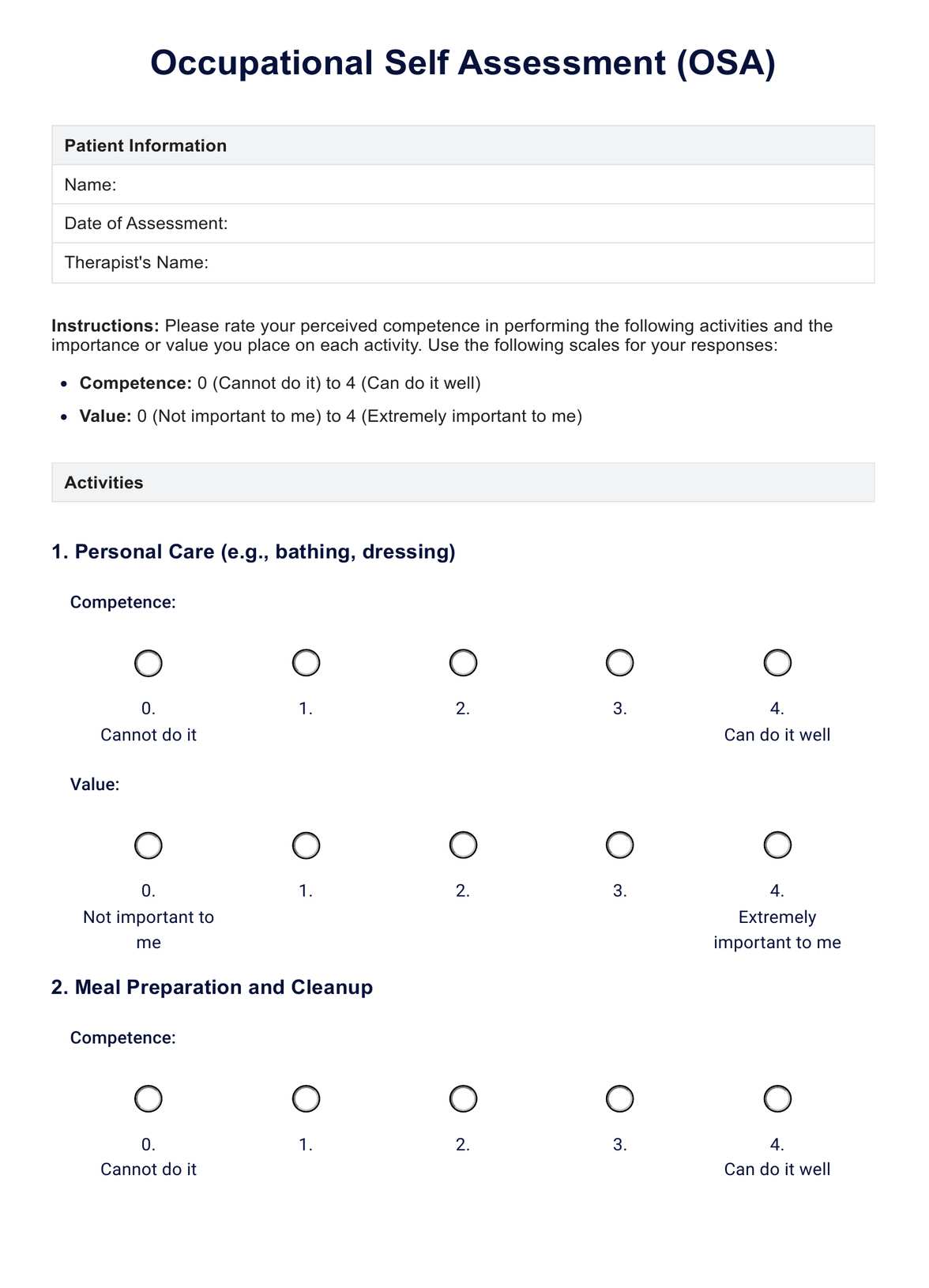
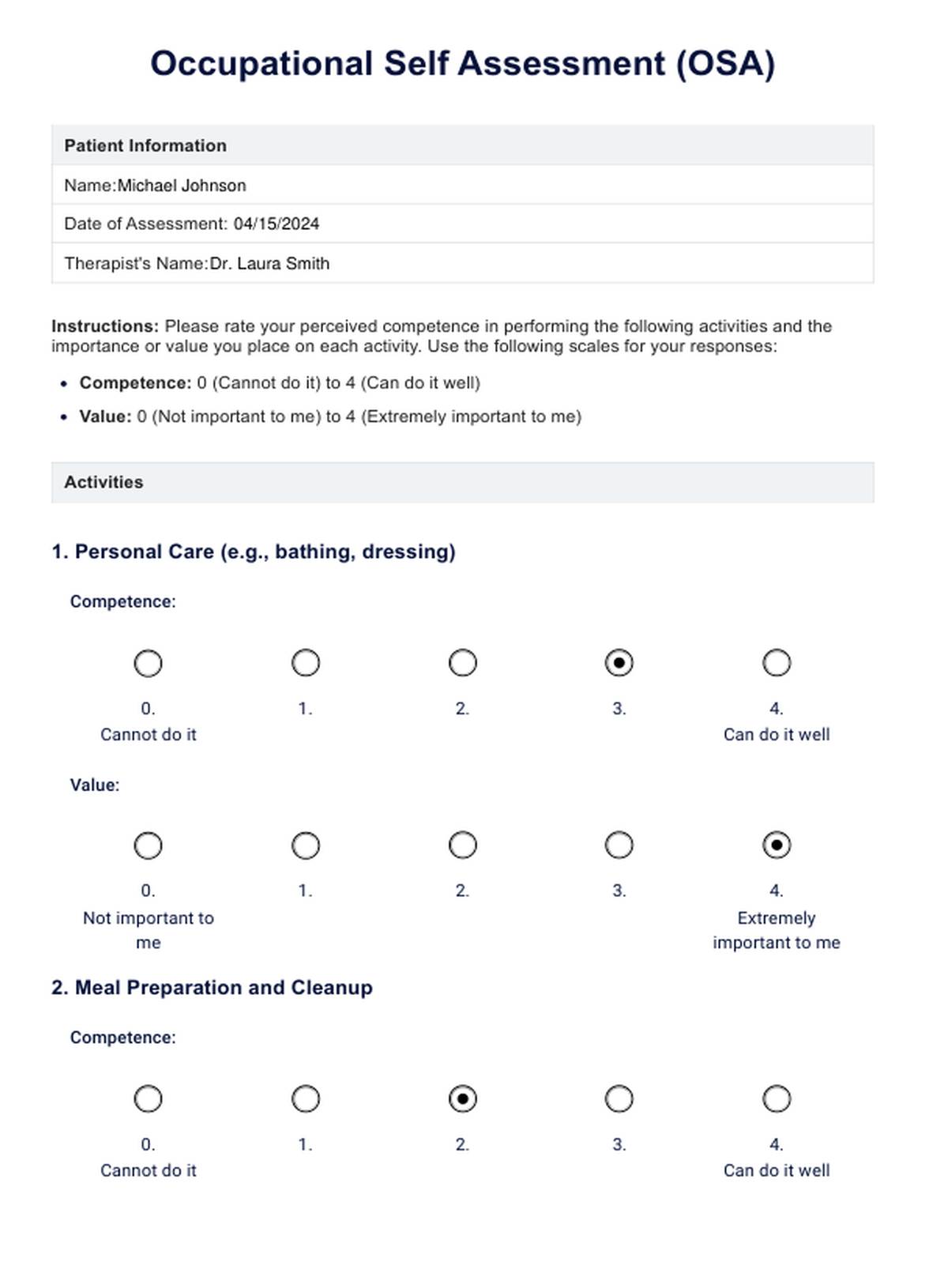

















-template.jpg)
























































































